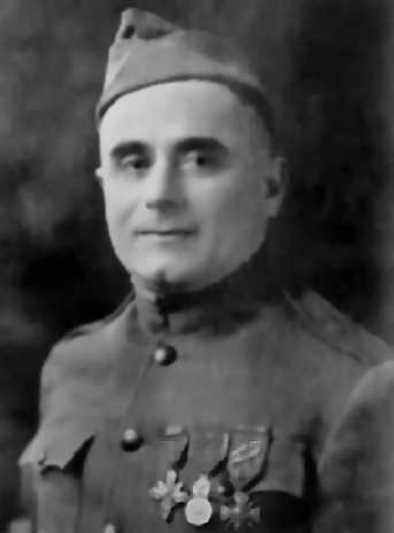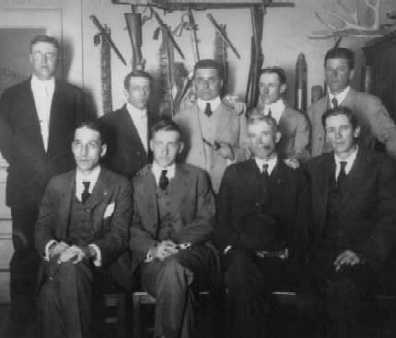The Kosher Kidnapping
By
Gerard Meister
(Researched and written by Gerard Meister)
The true story of the most improbable posse in the annals of Texas
Los Angeles, 1921. It all began, as so many strange happenings do, in L.A. It was early in the evening of June 18th and the sun was slowly sinking past the peaked rooftops of a sleepy residential block. The police had a house staked out awaiting the return of "Little Phil" Alguin, a 26 year old career criminal recently paroled from Folsom Prison. The slightly built Alguin, a hot-tempered Mexican-American, was suspected of pushing drugs from his home. In charge of the surveillance team was LAPD Detective John J. Fitzgerald. Fitzgerald and Little Phil knew one another. It was Fitzgerald's testimony that had sent the mobster to Folsom. But it was in that blinding, spilt second flash of recognition that the trigger-happy punk fired first, hitting the officer in the stomach. Mortally wounded, the detective staggered backward and fell to the ground. Fitzgerald's back up rushed to his side, but the stricken cop was beyond help. In the confusion Alguin, now a cop killer slipped away.
Louis D. Oaks, the Chief of the Los Angeles Police Department and a personal friend of the murdered officer, organized a nationwide manhunt for the cop killer. Feeling the pressure, Little Phil fled to Mexico after learning that Mexico, in the midst of a diplomatic tiff with United States, was not extraditing anyone. The fugitive made his way to Ciudad Juarez, a stone's throw across the Rio Grande from El Paso, Texas, and the home of one Samuel Dreben, 1st Sergeant U.S. Army (Ret.) and a famed soldier-of-fortune, who was known to friend and foe alike as "the fighting Jew."
Dreben, an observant Jew and a Russian immigrant from Kiev, took an even more circuitous route to El Paso (where he had settled in 1910). Arriving at our shores at the outbreak of the Spanish American War, Sam, wanting to do something for his new found land, enlisted in the Army and stayed for three hitches and four of our nation's wars. In one of Sam's tours of duty he was a scout for General Pershing during the Punitive Expedition against Pancho Villa in Mexico. Sam was also a key member of The Adventurer's Club of El Paso - a bunch of good old boys, ready for anything. So when Little Phil dropped into Juarez he soon found out that he had landed in Dreben territory.
Hatching the Plot
By mid-September, word reached Chief Oaks at the L.A.P.D. that Little Phil was holed up in Juarez, thumbing his nose with impunity at the police in El Paso. Oaks called his counterpart there, Chief Peyton Edwards, to ask for assistance. Oaks was told that El Paso stood ready to do its part to help nab a cop killer, and to come on down. The Los Angeles Chief spent the rest of the week tying up loose ends at the office, took the Pullman sleeper out of Union Station on Sunday night, September 24th, and got to El Paso early the next afternoon. He went directly from the train station to police headquarters to meet with his counterpart. The word "kidnap" was never spoken, but Oaks and Edwards knew that's where they were heading. A strategy meeting was set for the next morning, leaving it to Edwards to invite some good old boys; boys with the right kind of stuff. Edwards called Dreben that night. (The El Paso police chief, sensing the extent of the problem when he first spoke to Los Angeles, had briefed Sam the week before.)
It was an informal council of war; a round of introductions, then everyone grabbed a chair. Besides Dreben, Edwards invited his First Deputy, Captain W.A
Simpson, and Chief of Detectives, Claude Smith. When Chief Oaks began to clear his throat, Dreben shifted in his seat, " I have a plan," he said. All eyes turned to Sam. The ex-sergeant explained that after Chief Edwards first briefed him, he had slipped into Juarez a couple of times to get the lay of the land. He learned that Little Phil was extremely sensitive about a dead give-a-way tattoo on his right forearm, a flower superimposed with another of his sobriquets "Arizona Phil," and had asked a few local doctors if it could be removed, which in pre-laser days was next to impossible.
"All we have to do," Sam explained, "is open a doctor's office in Juarez, advertise that a new American specialist has arrived and his specialty was removing tattoos." Sam reasoned that Little Phil couldn't resist checking out a new doctor. "Then, when the killer drops into the office, we'll knock him out with a mickey or something put him in a waiting car and scoot across the International Bridge back to El Paso."
Sam, cocksure of himself, already had enlisted another Texan, San Antonio detective J. H. Kelly to act as the American doctor. (Sam and Kelly had served together as soldiers-of-fortune in Mexico.) Dreben had also talked a real M.D., Dr. R.H. Ellis, an El Paso physician, into being a "technical" advisor. (Sam had an easy time recruiting his posse, because Chief Oaks had posted a $5,000.00 reward when he came to El Paso.)
Dr. Ellis, a stickler for details, gave detective Kelly a short course on hypodermics, supplied a couple of syringes, the anesthetic (chloroform), some medical accouterments to throw around the office and a phony diploma to hang on the wall. The power of Dreben's persona was such that six grown men, including a physician and two police chiefs, all nodded in approval. Sam left for Juarez to rent something appropriate.
Tuesday, Sam put a couple of ads in local papers and printed up some handbills. Wednesday, the 'doctor' and his 'nurse' (a brilliant touch by Kelly) opened the office and began their wait. Nurse and doctor were astonished when Little Phil, as if on cue, walked through the door on Friday. After the doctor examined the offending tattoo, an appointment was made to perform the procedure next Monday in Little Phil's house, the only place where the wary con would agree to undergo anesthesia. The canny "Dr. Kelly" got a deposit out of Little Phil before he left.
The Posse Makes Its Move
That night the makeshift posse met and decided they would need two cars for the stakeout and getaway. Chief Oaks would drive one (no chance of his getting recognized), the others would pile into a cab, which, they believed, would make them invisible. After all, who takes a cab to a kidnapping? Everything was in motion: Detective/Dr. Kelly walked into Little Phil's house carrying a telltale doctor's bag, ordered his patient to lie down and administered the chloroform, while the stakeout cars (one hailed from the El Paso Public Livery stand!) got into position. All that had to happen now was for Kelly to spit through an open window, the agreed signal that the felon was out cold. As with all the best-laid plans, this one didn't work either. Little Phil was groggy, but not completely out. Dreben decided to make a run for it anyway by stuffing the fugitive on the floor of the car and then race across the bridge to El Paso.
By the time Little Phil was dragged from the house to the car, he was wide awake, kicking and screaming in Spanish that he was being kidnapped by gringos. A mob quickly gathered, blocking the car. Police were called. Sam, Detective Claude Smith, and the hapless cab driver were arrested, and Alguin set free. Kelly, who had melted into the crowd, made it back to El Paso, as did Chief Oaks who drove off when the trouble started.
The situation grew uglier by the hour. A lynch mob surrounded the jail. Only the timely intervention of one of Sam's legion of friends in Mexico, General J.J. Mendez, commandant of the local garrison, who had ordered troops into the melee with fixed bayonets, saved the Americans. The Juarez press screamed for the prisoners' execution.
When El Paso learned of Dreben's predicament the city came running. El Paso Mayor Charlie Davis led the charge. He appealed to Congress, the governor's office, the State Department and Army Chief of Staff, General John J. Hines (who, in a great piece of luck for Sam, was passing through El Paso at the time). Pressure mounted on Mexico to release the prisoners. American troops massed at the border. Mexico blinked. Sam and his cohorts were released after three days in jail.
Reporters asked Sam, who was fed only bread and water while in jail, how he managed. "It wasn't so bad the first day," he replied. "You see, that was Yom Kippur, and I wouldn't have eaten anyway."
Epilogue
Little Phil was eventually extradited and tried for the murder of the Los Angeles detective. Convicted in 1923 and given a life sentence, Little Phil was paroled in 1953. He disappeared into Mexico and was never heard from again.
Sam, who had moved to Los Angeles in 1924, died suddenly on March 15, 1925, from an overdose of medicine administered by an inexperienced nurse in his doctor's office. Upon learning of his death, the Texas State Legislature passed a resolution honoring Sam Dreben, lowered the Lone Star flag to half-staff and recessed for the day - a unique tribute to that remarkable man, the fighting Jew from Texas.
PICTURES:
(Top)Formal portrait of Sam wearing his American
and French medals shortly before his final days in
the Army, April 1919. Sometime later, the Belgian
and Italian governments decorated him, too.
(Bottom)The Good Old Boys of the Adventurer's Club in El Paso, Texas, 1920. Sam is standing, center. The gentleman seated in front of Sam, second from right, smoking a cigar, is "Tex" O'Reilly, noted adventurer, author, and newspaper editor. Sam was the only one of those 'boys' to make the "Little Phil" posse.


|